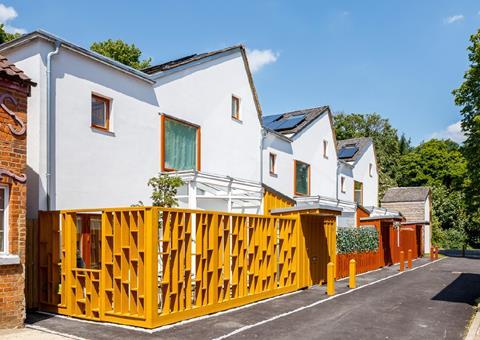Building Regs to mandate 30% cut in carbon emissions from new homes and 27% from other buildings from this summer - architects react
Updated: More industry reaction added
All new buildings must reduce their carbon emissions by about a third, the government announced today.
Building Regulations will be amended to enforce a 30% cut on emissions from new homes and a 27% cut on other buildings.
The new rules will come into force in June, with a transition period to allow for planning applications that are in progress at the time.
Junior housing minister Eddie Hughes said the change would pave the way for the Future Homes and Buildings Standard in 2025 and would mean all future homes would be net zero-ready and would not need retrofitting.
“The changes will significantly improve the energy efficiency of the buildings where we live, work and spend our free time and are an important step on our country’s journey towards a cleaner, greener built environment,” he said.

The announcements were set out in the Department for Levelling-Up, Housing and Communities (DLUHC)’sresponse,向公众谘询未来楼宇标准。谘询期由一月至四月。It details interim uplifts to Parts L and F of the Building Regulations and the introduction of Part O.
The initial response from architects was luke-warm.
RIBA president Simon Allford said: “These uplifts will bring us one step closer to decarbonisation, and we welcome that.
“The new minimum standards for fabric efficiency and new Part O signal real progress, but without regulation of actual energy use, the built environment will not decarbonise at the rate required. Regulations must continue to tighten.”
He said the RIBA would work with ministers to try and ensure the 2025 Future Homes and Buildings Standards addressed the urgency of the task at hand.
PRP partner and Building Design columnist Andrew Mellor was more downbeat.
He said: “We are currently undertaking work for clients looking at the future performance requirements of homes to hit a true net zero performance. That analysis shows that the likely Future Homes Standard requirements do not go anywhere near far enough and that developers will have to go much further to hit the RIBA 2030 standard and even further to meet the LETI standards.”
“Architects and developers need one standard from government, membership bodies and the advisory groups which achieves true net zero. Disparity between standards will not help industry to achieve the net zero goal.”
He demanded embodied carbon be included in the 2025 Future Homes Standard and said the date must not be allowed to slip like others have.
He said the new overheating assessment requirement was very welcome and should help to minimise some of the thermal comfort issues in homes and reduce the predicted annual deaths from heat stress.
多学科工程公司Cundall的可持续发展合伙人艾伦·福格蒂对第L部分咨询文件中提出的更高目标的采用表示欢迎,认为这是“朝着2025年雄心勃勃的减排迈出的重要一步”。
他补充说:“在通风要求方面,咨询建议增加50%的风量,这可能会造成很大的能源损失,因为通风系统将不得不付出更大的努力。这一点已从最新的文件中删除,这也是受欢迎的,因为如果项目的设计目标是净零碳排放,它们无论如何都有可能实现更高的税率。使用可打开的窗户可以很容易地实现这一点,而且不消耗能源。”
Matthew Goulcher, managing director of Levitt Bernstein, said: “As the latest IPCC report has highlighted, this will be our last chance to make a meaningful difference as a sector.
“Building Regulations must step up now if we wish to avert the devastating consequences of the climate emergency.
“While we welcome the improvements to fabric efficiency, these do not go far enough. We need to set standards that are based on actual and measurable energy use targets and then ensure that these are met in practice. We have the technology and means to do this now, so why wait another four years?”
On behalf of LETI (London Energy Transformation Initiative), which won Building Design’s Leader of the Year award in October, Alex Johnstone said: “This is a time when we need both progress and clarity in terms of metrics. The 2021 uplift has not provided these.”
The group said it was disappointed by the Part L reforms. Thomas Lefevre said: “The introduction of a primary energy metric goes against the views of the industry, who have specifically has said it is unhelpful and confusing. 80% of the consultation responses told the government that a primary energy metric should not be introduced, yet the government has not listened.”
Brian Goldsmith, UK and Europe director at engineers Elementa Consulting, said: “We understand that the 2021 regulations are an interim uplift before the FHS and the FBS but we are disappointed that DLUHC has not taken on board the industry feedback of recommendations from their consultation.
“很高兴地看到,临时法规提高了标准,并引入了批准文件O:过热。这是欢迎的。然而,一次能源指标的引入令人失望。推动建筑性能的关键是实施总能源使用指标,可以在使用中测量。”
UKGBC director Simon McWhirter praised the government for taking forward the more ambitious Part L improvement options within the consultation, alongside new requirements for tackling domestic overheating.
他说:“这是朝着我们的建筑脱碳的正确方向迈出的重要一步。”
“However, there were overarching details missing which could and should have clarified what more will be done to deliver net-zero buildings by 2050.
“尽管我们欢迎政府承诺发布一份意向声明,以解决隐含碳和绩效差距,但今天没有看到这些必要的、明确的和雄心勃勃的提议,令人失望,特别是英国政府bc的终身碳路线图表明,在这些问题上采取紧急行动至关重要。”
The UKGBC roadmap shows that embodied carbon will form over half of all built environment emissions by 2035.
新规将于2022年6月15日起施行。德法高等研究院表示,未来6个月的过渡安排意味着,如果在2022年6月15日之前向当地政府提交建筑通知、初步通知或建筑工作的完整计划,那么,如果建筑工作在2023年6月15日之前开始,单个建筑的工作将按照以前的标准进行。
Ministers said the government was providing £6.6bn of direct investment into improving the energy efficiency of buildings during this Parliament through schemes such as the Social Housing Decarbonisation Fund, Local Authority Delivery scheme and Home Upgrade Grant scheme which make grants to low-income households for measures including insulation, solar panels and heat pumps.
但去年拙劣的绿色住宅拨款计划被议员们认为是失败的,因为在政府叫停之前的4个月里,15亿英镑的资金只花了5%,让许多建筑商和安装商陷入困境。
>> From the archive:Explainer: How the proposed Future Buildings Standard will affect the way you design
In April a coalition of architects, built environment and climate groupswrote to the permanent secretaryat the then MHCLG, Jeremy Pocklington, highlighting what it described as “significant shortcomings” in the proposed Future Buildings Standard.
The 21 signatories who included the RIBA, Architects Declare, the Architects Climate Action Network and the UK Green Building Council, said the government must be far more ambitious in the way it regulates the energy consumption of new buildings.
The letter outlined serious concerns about the proposed new energy and ventilation standards for non-domestic buildings and existing homes in England. Alongside ambitious new standards, the letter also called for a national retrofit strategy to discourage the demolition of salvageable buildings.
Postscript
你觉得这个消息怎么样?这对你的实践意味着什么?Email our newsdesk atelizabeth.hopkirk@bdonline.co.ukor use the hashtag #BDFutureProf on social media - or comment below
















4Readers' comments